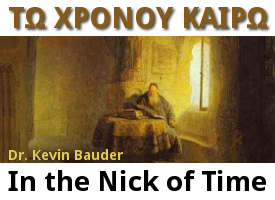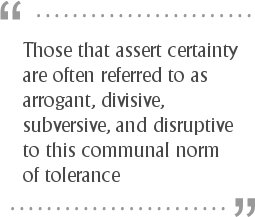Now, About Those Differences, Part Twenty Two
 The entire “Now About Those Differences” series is available here.
The entire “Now About Those Differences” series is available here.
As iron sharpens iron,
one person sharpens another. (Proverbs 27:17)
 The entire “Now About Those Differences” series is available here.
The entire “Now About Those Differences” series is available here.
 The entire “Now About Those Differences” series is available here.
The entire “Now About Those Differences” series is available here.
 Republished with permission from Baptist Bulletin Nov/Dec 2010. All rights reserved.
Republished with permission from Baptist Bulletin Nov/Dec 2010. All rights reserved.
by David Mappes
Imagine you are the quarterback in a bowl game, dropping back for a pass. As you look downfield, you notice that all the players on both teams are wearing jerseys in subtle shades of gray—and you can’t tell them apart. Confused, you call for a huddle and begin reading from the playbook strapped to your arm. Players interrupt and begin to argue, shouting “No, that’s not what the coach means by ‘screen pass!’” “Yes, it is!” and then, “That’s just your interpretation!”
This imaginary scene may seem chaotic, but it is a fitting description for current trends in hermeneutics and theology. Careful pastors and church members need to understand subtle but important differences in terminology that are being adopted by a new generation of scholars.
“Hermeneutics” comes from the Greek term hermeneuo, which carries the idea of explaining, interpreting, or translating the sense of one language to another. In a more technical sense, the term denotes the science and art of interpretation; thus various rules and norms of interpretation are employed to determine the author’s meaning in the text. These interpretive principles are not always fully agreed upon or consistently practiced, but until recently, literary scholars have agreed that the author’s intended meaning could be understood and correctly applied. And until recently, evangelical believers have contended that we can understand the Author’s intended meaning and apply it to our lives.
 The entire “Now About Those Differences” series is available here.
The entire “Now About Those Differences” series is available here.
Fundamentalists have agreed that Christians have no fellowship with those who reject the gospel. They have agreed that people who deny fundamental doctrines are apostates who must never receive Christian recognition. They have agreed that such apostates must be removed from Christian organizations and enterprises. If the apostates cannot be removed, fundamentalists have agreed that the organizations themselves must be deemed apostate. At some point, Christians have a duty to abandon the organizations and to begin new fellowships in which the integrity of the gospel is maintained.
While fundamentalists have agreed on these principles, they have often disagreed on certain points of application. What constitutes an expression of Christian fellowship? When does an organization become apostate? When is it time to shift from “purge out” to “come out” separation? Are there good, tactical reasons to stay in an apostate organization temporarily? Fundamentalists have given different answers to these questions.
More recently, fundamentalists and conservative evangelicals have also tended to answer these questions differently. Examples are abundant and, in some cases, matters of public dispute. Albert Mohler was willing to join Roman Catholics in signing the Manhattan Declaration. He was willing to help sponsor the Billy Graham Crusade in Louisville. Southern Baptist Seminary (president Al Mohler, board chairman Mark Dever) dedicated a pavilion to Duke McCall, the “moderate” president under whose leadership heterodoxy flourished in that institution. For all his criticism of Open Theism, John Piper has not led Bethlehem Baptist Church out of the Baptist General Conference (now Converge Worldwide).
Mohler, Mahaney, Driscoll, DeYoung, Duncan discuss the New Calvinism.
 Read Part 1, Part 2, Part 3, Part 4, Part 5, Part 6, Part 7, Part 8, Part 9, Part 10, Part 11, Part 12, Part 13, Part 14, Part 15, Part 16, Part 17, and Part 18.
Read Part 1, Part 2, Part 3, Part 4, Part 5, Part 6, Part 7, Part 8, Part 9, Part 10, Part 11, Part 12, Part 13, Part 14, Part 15, Part 16, Part 17, and Part 18.
Fundamentalism 101 is pretty clear. It teaches that the gospel is the boundary of the Christian faith, the Christian community, and of Christian ministry. Spiritually, Christians hold nothing in common with people who deny the gospel. Therefore, Christians must never extend Christian recognition or fellowship to people who deny the gospel.
Some people deny the gospel explicitly. Perhaps they are adherents of pagan religions. Perhaps they are atheists. At any rate, they are easily recognized for their denials of the gospel. They reject Christianity altogether and without pretense.
Other people, however, claim to affirm the gospel even though they deny teachings that are essential to it. Such essential teachings are known as fundamentals. To deny a fundamental is to deny the gospel itself, and to deny the gospel while claiming to be Christian is just as serious as rejecting Christianity altogether.
In fact, it is more serious. To deny the gospel while claiming to be Christian involves a level of duplicity and hypocrisy. The New Testament has much to say about people who do this. Paul mentions those who preach another Jesus, receive a different Spirit, and accept a different gospel (2 Cor. 11:4). In a different place, he anathematizes them (Gal. 1:6-8). John commands believers not to welcome such individuals or even to give them a civil greeting (2 Jn. 10). The entire epistle of Jude and the second chapter of Second Peter are directed against these people.
 The entire “Now About Those Differences” series is available here.
The entire “Now About Those Differences” series is available here.
Fundamentalism surfaced in about 1900 as a doctrinal and ecclesiastical reaction against the influence of theological liberalism. It did not, however, begin ex nihilo. It grew out of an American evangelical coalition that stretched across the denominations, produced the Bible conference movement, built mission agencies and Bible institutes, and produced The Fundamentals. This coalition has come to be known as proto-fundamentalism.
By 1920, proto-fundamentalism had become less well defined than it had been in the 19th Century. Around the turn of the century, a generation of leadership had died off. New leaders took time to emerge. In 1914, attention was diverted by a war in Europe and, eventually, around the world. The result was that proto-fundamentalist efforts tended to be more sporadic and desultory than they had been before 1900.
If proto-fundamentalism had lost definition by 1920, early fundamentalism had not yet gained definition. The people who took the label fundamentalist clearly aimed to oppose liberalism, not merely doctrinally, but also ecclesiastically. Nevertheless, Laws’s original definition did not specify who actually belonged in the movement and who did not. The result was considerable confusion.
Oliver W. Van Osdel, pioneer separatist and father of the Regular Baptist movement, refused to be called a fundamentalist. He saw fundamentalism as a weak and compromising effort. J. Gresham Machen made the best case for fundamentalist ideas, but he was uncomfortable both with fundamentalism’s doctrinal minimalism and its populism.
 The entire “Now About Those Differences” series is available here.
The entire “Now About Those Differences” series is available here.
Continued from last week…
To fundamentalists, Graham’s conduct was as inexplicable as it was inexcusable. True, Graham preached the gospel. In his conduct, however, Graham effectively denied the right of the gospel to define the boundary of Christian faith and fellowship. At Fuller Seminary, Carnell opined that some liberals were more pious than fundamentalists; Graham simply put Carnell’s theory into action.
As far as fundamentalists were concerned, faithfulness to the gospel required repudiation of the neo-evangelical agenda. Fundamentalist leaders could not endorse what Carnell said and they would not participate in what Graham did. It is not simply that they saw Graham’s conduct as sinful—they saw it as a scandalous betrayal of the gospel itself. They refused to recognize Graham, Carnell, and their ilk as legitimate Christian leaders.
This is the practice that some labeled “secondary separation.” Whatever one thinks of that label, it is clear that separation from neo-evangelicals was no afterthought or appendage to fundamentalism. It was the only faithful way of implementing fundamentalist ideals.
Theological liberalism is apostasy and liberals are apostates. Apostates are enemies of the gospel and, therefore, enemies of Christ. To extend Christian fellowship to an apostate (a liberal) is to make common cause with Christ’s enemies against Him. If an apostate is an enemy, then a neo-evangelical must be considered a traitor to the cause of Christ. Why would anyone point to such a person as an example of Christian virtue? How could a fundamentalist knowingly follow such leadership?
Fundamentalists did not separate from neo-evangelicals because of petulance. They separated because they really had no choice. The gospel was at stake. It was being denied by liberals and betrayed by neo-evangelicals.
Separation from new evangelicalism was necessary, and by the mid-1960s it had become a characteristic of fundamentalists. At this point in history, however, some fundamentalists adopted attitudes that guaranteed the disintegration of their movement. Not all fundamentalists shared these attitudes, but those who did managed to confuse the idea of fundamentalism in important ways.
Discussion